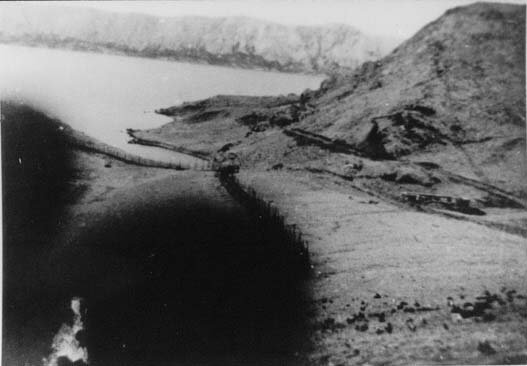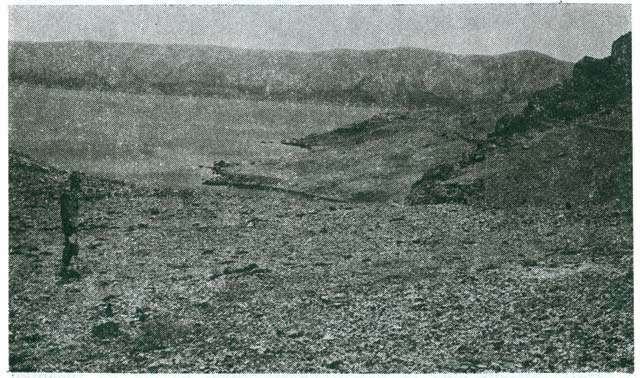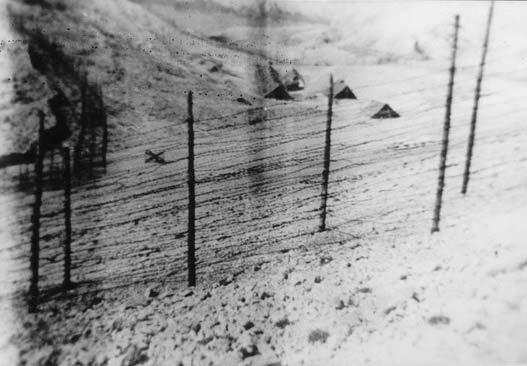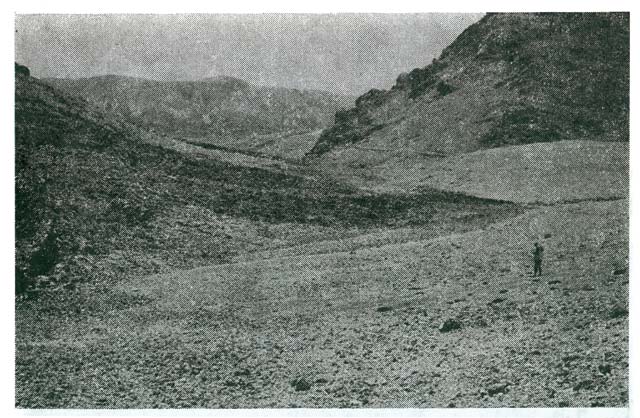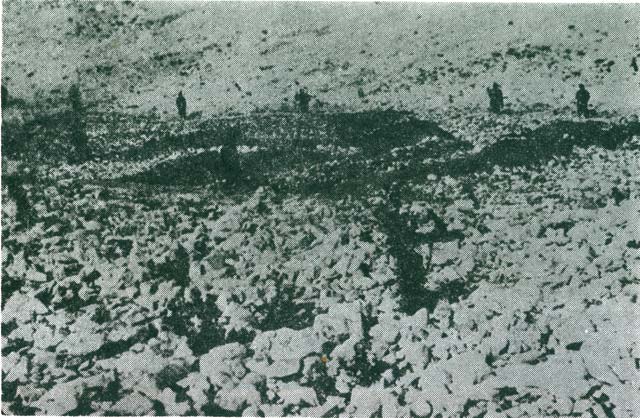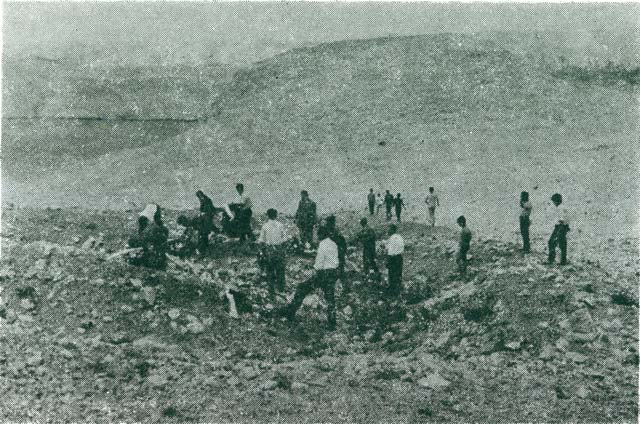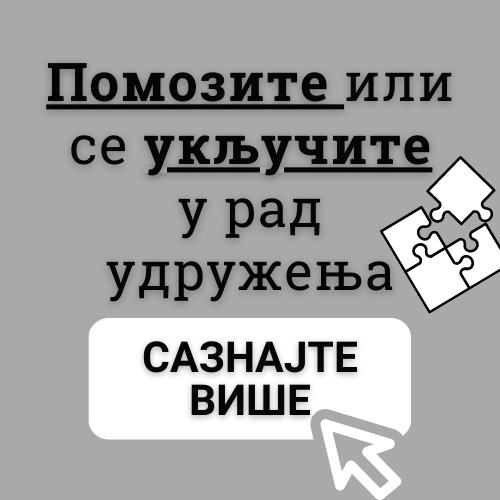TO MILITARY HEALTH DIRECTORATE OF V ARMY CORPS
SUBJECT: Report on temporary gravesites in our zone
The Health Directorate tasked me to examine the temporary gravesites in our zone in order to prevent potential contamination of water and to conduct testing with coloured chemicals. I report:
Day 1:
September 1, 1941. Movement: Crikvenica – Senj – Gospić – Perušić – Pazarište – Perušić – Bunić – Perušić – Gospić-
I left Crikvenica at 6.30am in the car number 1514; arrived to Senj at 8am where I introduced myself at the Command of “Re” Division and gave them the letter number 03/4145 dated August 31 sent by this Directorate (see attachment); here I handed in letters sent to garrison commands in Gospić, Karlobag and Pag, which contained authorisation to examine waters and a request for military assistance.
On the same morning I left for Gospić where I arrived at 11am.
The command of the infantry unit gave me three armed soldiers and containers to make solutions of coloured chemicals.
On the return to Perušić I obtained certain useful information from several citizens in terms of locations of the victims, general situation and the mood amongst the citizens. Right after that I went to Pazarište.
All of the people refused giving any information, denied that Serbs had been brought here and killed, also because this area is exclusively Catholic.
Despite that, one villager took me to Levareva Kosa where a pit where Serbs had been thrown in is located.
In Levareva Kosa they showed me only one pool of running water coming from the suspicious zone. This is where the villagers take water from their daily needs (see photos number 1, 2 and 3).
In this pool I poured a chemical diluted in 50 litres of water.
On my way back to Perušić I carefully managed to find out vague information from the villagers, often conflicting. However, convinced that there had to be a pit somewhere around, I came to the village Klanac. Realising that I would not reach my goal with nice manners, I used force on one of the villagers so he would take me to a circular pit. Together with this villager and with another boy I reached the Plana pit which is located above the village of Buđak (Budijak), Klanac Municipality. There were no roads or paths here. I left the car with one guard on the road (see photos 4, 5 and 6).
In order to reach this location we had to walk for about an hour. On the way we found a lot of shell casings from military and hunting rifles. In the area around the pit I found pieces of chains, padlocks of various sizes and shapes, railway employee badges, ribbons from trousers of Yugoslav customs officers, toothbrushes, pocket mirrors, combs, and very interestingly, emptied and torn wallets (and purses for coins). On one spot I found pieces of a skull for which I believe to belong to an adult person between age 30 and 50, killed approximately two months before.
The opening of the pit is 8x5m in size, and it seems to have no bottom. A rock I threw in did not stop, but fell so deeply that I could not hear it hit the bottom. The rim of the pit and its sides were covered with lime that seemed to be used several days before. Despite that the whole area is full of terrible smell of decomposing corpses. It seems that around 500 victims were thrown into this pit. I made a chemical solution and threw it into the pit.
On my way back, peasants from the surrounding villagers caused me a lot of uncomfortable situations and difficulties for two reasons: they were afraid of an Ustasha retaliation, and also that they would loose items they got for safekeeping (allegedly) or stole after the massacre of Serbs (cattle, grain, clothes, etc.)
Besides the pit I described, there are others close to the sea: first, Ličko Lešće behind the Macola Pub (Makola?); second, Kuzmanovac; third, Jadovno (with very few victims); fourth, Ribnik; five, Donji Lapac (at the very end of our zone); six, Medak, near Gračac (territory of VI Army Corps).
When I came back to Perušič I found out that there are many destroyed villages and unburied corpses on the road leading to Bunić, so I decided to visit it (see photos 7 and 8).
In fact, on the road leading to Bunić many of the villages are partially or completely destroyed or burned. Few undamaged houses are still inhabited and belong to Croats. I could not find any Serbian house that was not vandalised. Along the road I saw a lot of armed citizens, and after a couple of kilometres I heard gunshots coming from three to four hundred metres.
After I visited several village houses, I saw they were completely empty just as the stables. Everything was an image of violence.
Around the houses I found piles of excavated earth which seemed to be pits with corpses.
I met a family of Serbs who hid in a forest. They informed me that they had dug out the pits to bury the corpses of Serbs (see photos 9, 10, 11 and 12). In fact, I did not find a single corpse that was left unburied. Also in Bunić, Serbian houses and the church were burned.
I went back to Gospić.
Day 2
September 2, 1941. Movement: Gospić – Oštarije – Karlobag – Tribalj – Karlobag
At dawn, after I refilled the car with petrol I went to Oštarije. As soon as I arrived I met shepherds and villagers I had met before. Nobody remembered telling me anything about the transport of Serbs and all of them repeated the same phrases that they did not know anything since the were not present. I realised that my attempts to find local pits would be in vain so I continued to Karlobag where I presented myself to Colonel Stagni with a letter.
Around 11.30am, following Colonel Stagni’s advice, I went to Triblje (Tribnje, author’s note). After I spent some time with Lieutenant Zucco Leli and 6 soldiers I arrived to Mandalina and took a path leading to a large pit, named Jamina. For safety reasons he advised me to return the car to Tribanj.
At the beginning there is a steep path leading to the pit, but later on we had to go through caves jumping from one rock to another (see photos 12, 13, 14 and 15). The last village on the way to the pit is Livadice and it is very close to the pit and we used two villagers to show us the way. In order to get there we had to walk for two and a half hours over rough terrain, and I do not understand how the victims, women and children, arrived to this place, moreover because they had been allegedly brought here at night.
The pit itself is located on the eastern edge of a small meadow and its opening is 8x6m. I cannot say how deep it is since the rock I threw in did not stop by the time I could still hear it falling. In some dents on the inside of the western side of the pit I could see pale and broke roots and I assume it happened when victims scratched the earth while falling. It is not possible for me to specify the number of victims, but without a doubt, hundreds were thrown in the pit, some of them from the concentration camp on Pag.
The Croatian authorities did not conduct any preventive disinfection.
I made a mix of chemicals and threw them into the abyss.
On my return from the described location, I asked some villagers to describe the events, which they could not, perhaps because they were removed from their houses before the massacre. From Mandalina I went to Karlobag.
Day 3
September 3, 1941. Movement: Karlobag – Pag Island – Slana.
At 7.30am I left Karlobag in a motor ship R.G. Finanza (of Royal Naval Border Service, author’s note) accompanied by Colonel Stagno.
Facing Karlobag directly is the northeast side of Pag Island, called Slana, in the shape of a rocky strip with very scarce vegetation and at very few places. There is no road and you have to climb over boulders. In our ship we sailed through the Pag Gate and continued to a small bay facing the town of Pag. We found a makeshift rocky dock (with no cement) and our ship docked with no problems.
When we got off we saw two concentration camps 100m apart (see photos 16, 17 and 18).
The first and the larger one was located on the right in a vale and it was surrounded with two rows of crossed barbed wire with two openings (gates), one opposite from the other. These (gates, author’s note) had Frisian horses so that the camp could be completely closed. One of the islanders told us that this camp was Serbian and had as much as 1200 people in some days. In the centre there was a barracks that could hold around 180 people, which means that the others had to stay in the open on rough terrain and exposed to the sun. As I said in this area there is no vegetation or shade. The barracks is now dismantled and the boards lay on the camp centre. There are also two primitive camp latrines with very little contents.
The second camp is located on the left and surrounded with one row of barbed wire and it was primitively built. First Jews then women were held here.
At the front, between the camps is a house under construction with construction material around it.
On the left from the second camp there is a road under construction which the inmates were building.
At the dock, in the shade under a boulder, there is a pit containing water. This is the only pool which the inmates must have used for all their needs. We went through the right hand side camp and not far from it we came across numerous ditches covered with earth and rock where undoubtedly victims from the camp had been buried.
When we crossed the hill south from the camp, we came to a small vale with excavated earth and rock which was in fact a mass grave. This excavation is 150m long and 20m wide (see photos 19, 20 and 21).
Out of curiosity I scraped the transversal ditch and at the depth of 50cm I found a woman covered with a pillow and an umbrella next to her. Next to this corpse were numerous other corpses, including children, all of them decomposing heavily with sharp and unbearable stench. They had been killed about a month before. It would be difficult to determine the number of the dead in this ditch, but there must be many and in different positions. One part of the ditch was still empty and intended for new victims (see photo 22).
These ditches were dug out by camp inmates and they were brought here with a promise of searching for the bauxite ore. The others were brought here from the camp with the promise of going for work in Germany. In fact they were brought close to the ditch, killed then thrown in. It was obvious that many of them were buried while bound and still alive. The distance from the sea to this mass grave is no more than 200m, and people say that many of them were thrown into the sea on their way here (see photo 23).
150 metres from this grave site there is a smaller one 10x2m in size on a location sloping down to the sea. Again out of curiosity I started to dig and found a corpse of a man, probably around 18 years of age, very skinny and decomposing. Next to him there were several groups of corpses in impossible positions, some of them still bound.
The first corpse was covered with only 15cm of earth and few rocks. The ditch is 1m deep and contains a small number of corpses in all imaginable positions. On the rims of the ditch I found a lot of rifle shell casings.
In the same area of the island there must be many individual graves of people who died at work.
My assessment is that the number of people brought to the camp is around 8 to 9 thousand. They were brought to the island from Karlobag with 4 ships and with 200 people on every transport. They were often brought to the camp directly from the northeast side of the island, disembarked in the area facing Karlobag and then walked to the camp across the desolate and rocky area (see photo 24).
There were around 70 Ustashas guarding the camp under the command of Lieutenant Devčić, and they had machinegun nests on elevated pointss that dominated the whole zone (7 machinegun nests).
Civilians were not allowed to come close and fishing in that area was also forbidden. The camps were often overcrowded and then Ustashas would take women (Serbian and Jewish) to a village, by the name of Barbat, where they lived in two houses. In one of the houses they killed a daughter of a Serbian general from Zagreb after they had raped her.
The food was more than poor. Often a piece of bread would be divided between 12 people.
The corpses were not buried enough. Somewhere I found them buried just at 15cm and my conclusion that autumn rains could excavate the corpses that are in such shallow graves. The Croatian authorities did not conduct any preventive disinfection.
We poured a solution of a chemical into the ditches of the large grave sites between the rocks.
On my way back from the island to Karlobag, I managed to go through documents that had been found near a pit close to Oštarije. They had been collected by Captain Luigi Asti who went with his soldiers to search the terrain for pits in this zone. Drawn by a terrible smell he managed to discover a pit by the name of Jama na Pločama.
Here he found IDs, food stamps, letters from victims’ relatives, and one verdict issued by a court for theft of wood sent to a resident of a village close to the pit by the name of Ustasha Luka Baburić.
Day 4
September 4, 1941. Movement: Karlobag – Oštarije – Karlobag – Crikvenica.
At 6am I was on the road with Captain Asti Luigi and 30 armed soldiers of G.A.F. (Gvardia dalla frontiera). When I arrived to Oštarije I left the vehicles on the road and took the path to the village of Stupačinovo. When I found a brother of Luka Baburić, mentioned in the document found the day before, and with another 4 villagers we went to the Jama na Pločama pit and arrived there after a short walk. The pit is located on the northeast part of Stupačinovo village, surrounded by trees and well hidden. Some sort of vapour with sharp smell was rising from it. The entrance to the pit is open and 9x6m wide. When I threw in a rock I heard it fall into water after a long drop. On one part of the entrance the earth was scraped and the grass was flattened. We found here pieces of shirts and men’s clothes. Next to the pit there were pieces of human hair, letters, photographs, empty and torn coin purses and wallets, shell casings, etc. (see photos 26, 27 and 28).
People say that around 2000 Serbian men were brought here on several occasions and were thrown into the pit, and that the last slaughter was three weeks before.
The Croatian authorities did not conduct any sanitary procedure.
I made a solution using water from a nearby spring and threw it into the pit.
While the villagers escorted us to the Jama na Pločama pit without any objections knowing that we had discovered it the day before, they refused to help us find the second pit. When we started to insist the villagers scattered towards the mountain heading west from Stupačinovo village. We were left with no results.
I returned to the point of departure and took the troops to conduct a search. We managed to find the second abyss by the name of Duliba Jama (see photo…).
This pit was covered with branches and leaves and well hidden. On a path near the pit we found pieces of clothes, handkerchiefs, IDs, shell casings from military rifles, various toothbrushes, even a broken men’s wrist watch.
I ordered the villagers to uncover the pit. At the same moment we felt a strong and unpleasant smell typical for advanced decomposition of flesh (see photos number 29 and 30).
The pit entrance is 8x8m. The rocks next to the opening were covered with blood stains and greasy matter. On one spot we found a stain made by bloody fingers.
Around 200 persons had been thrown into this pit and the murder had been committed recently, around one month ago.
No disinfectants were used in this pit as well.
Here I also threw in a solution of chemicals.
In the afternoon I went back and arrived to the north in the evening (Crikvenica).
Conclusion
I – The Croatian authorities did not take any preventive measures for the named pits, except for the first one (Plana on Buđak) where they poured very small quantities of lime. Piles of corpses present danger to the pollution of running waters in Lika and the Coast.
II – In Slana graves – Pag Island – corpses had been buried very shallow and during autumn rains there is a possibility they will be uncovered so they present a toxic and infective danger.
Military Post Office 41 – September 6, 1941/ XIX
Seen by:
Colonel Doctor Director 2nd Lieutenant Doctor Q.G.
(Muzio Fiorini) V Army Corps
(Finderle Vittorio)
MILITARY HEALTH DIRECTORATE of V Army Corps
Military Post Office 41
After reviewing the report by Lieutenant Dr. FINDERLE, I propose:
I – to insert a large quantity of lime in the pits Plana above Buđak (Klanac Municipality), Jamina, Jadovno, Kuzmanovac, Ličko Lešće, Jama na Pločama and in Duliba Jama so that a sufficient layer of this protective substance covers the corpses.
II – to excavate corpses buried in Slana on Pag, collect and put them on pyres and soak with flammable and combustible liquids. The excavated trenches should be covered with quicklime. The disinfection should be performed by our attached Disinfection Department supported with troops from neighbouring towns. The disinfection is to be considered urgent.
Military Post Office 41 – September 6, 1941/ XIX
Lieutenant Chemist – Pharmacists
Mario Spote
Colonel Doctor Director for Health
Muzio Fiorini
V ARMY CORPS COMMAND
Office of S.M. – Service
Number 3919/ Auxiliary service, SECRET
Military Post Office 41 – September 8, 1941/ XIX
Attachment number 2.
SUBJECT: Hygienic protection
… titles…
According to the report – separately enclosed for “Re” Division (attachment number 1), special attachment for the Health Directorate – Disinfection Department – (attachment number 2) – delivered by Lieutenant Dr. Finderle who had the duty to find locations in the territory of the Army Corps where the corpses of victims of the last political events in Croatia are buried, in order to prevent potential contamination of water, it is necessary to urgently:
I – insert lime into pits, those in attachment number 3 and others if necessary;
II – excavate corpses buried in Slana (Pag Island), burn them and disinfect the excavations.
The disinfection according to attachment number 1 will be conducted by “Re” Division through its health service. The amount of lime must be abundant: 8 – 10 quintals per pit (1 quintal = 100 kilos).
Lime will be purchased in the surrounding area.
The disinfection according to the attachment number 2 will be conducted by the Health Directorate which will be transported by sea from Kraljevica to Pag and then go to work in Slana from here every day.
The transport will be conducted in a motor ship “Venus” which will be in Kraljevica on 9th this month at 7am and made available to the Disinfection Department.
The Disinfection Department is to take with them their petrol and paraffin ration (450 and 100 litres). On their way to the base they will ask the Technical Office of the Army Corpse for the compensation for the amounts spent.
The lime will be purchased on site.
The Disinfection Department are to take with them five days worth of additional food rations. For bread, meat and other rations they will rely on the Pag military command which have already been informed by the Army Corps Commissariat Directorate.
As ordered, Chief of Head Department, Colonel
Clemente Primieri.
MILITARY HEALTH DIRECTORATE OF V ARMY CORPS
Number 01/1675
Military Post Office 41 – September 9, 1941/ XIX
To the Directorate of the Disinfection Department
… to execute the order
Colonel Doctor Director
Muzio Fiorini
TO DISINFECTION DEPARTMENT, DIRECTORATE
Military Post Office 41 – September 21
1941/ XIX
SUBJECT: Hygienic protection and disinfection of the gravesite in Malin in Slana (Pag Island).
After receiving an order to deploy from the V Army Corps Health Directorate, on September 11, 1941 – XIX, with one non-commissioned officer and 34 men from the company, I departed from Kraljevica to Pag in a motorised sail ship “Venus”. We departed at 7.30am and arrived at 7.30pm. The company and equipment were deployed.
At dawn the next day I left Pag towards location Malin which is deep in the Pag Bay and where we had been told the biggest grave site was located.
We arrived after one hour on a ship. The ship could not dock due to shallow waters so that the transport of men and equipment was conducted in a boat (see photos 1 and 2) brought here and this would remain the same in the next ten days of work.
Already in the anchor zone, and even more close to the ridge where we disembarked, we felt a terrible smell typical for decomposing organic matter. After we climbed a path over a barren and tragic terrain we were 400m above (see photo 3) and in front of a pit 32m long, 2m wide and 1.5m deep (see photos 4 and 5). During our walk we were forced to use gas masks, because the smell became unbearable and the climb made us breathe deeply. The pit parallel to the vale we crossed was closed at the two ends with two drywalls. The excavated earth which was on the sides was supported with drywall. The bottom was rocky which was discovered with a couple swings of a pickaxe. At a distance of 15m was another pit tangent to the first one, 15m long and wide and deep as the fist.
Around the two pits we noticed some earth that had been removed and covered with numerous rocks in order to imitate the terrain. However, rain made the soft soil settle revealing the rocks. With small probing we could see that the trench moved into two directions: 8m towards the sea and 35m towards the hill, while the latter had six more additional arms. This area reeks with heavy smell of putrefaction, and some removed earth revealed twisted hands and toes already rotten, and at some place contours of human bodies poorly covered with earth could be seen. In one part where the terrain was unusually elastic, we could see a belly of a woman after digging just few centimetres.
After another 400m we reached the top of the vale. Going across it descends into another vale called Karlobaški Malin looking towards Karlobag. Walking for another 300m over completely rocky terrain with no road we came across a trench of removed earth 50cm wide and 20m long. The removed earth was covered with rocks to mask it, and there was also that characteristic smell.
On some places hands and shoes were sticking out. I divided the men into two groups. We worked methodically, removed all rocks from the excavated earth, and then carefully with shovel removed the earth layer by layer over the whole gravesite. After the first 5 to 20cm removed we saw many hands, often bound (see photo 6), bare feet, sometimes with shoes, heads looking upwards or with necks exposed.
Although we had already got used to limbs and heads sticking out, there was something particular about the way they had been buried. It was almost a rule to find a layer of rocks on corpses after a layer of earth had been removed and we had to remove the rocks as well to continue digging.
We tried to explain these rocks so we did a test on the empty part of the ditch. We came to a conclusion that the burial had been conducted in the following way: the people they were supposed to kill, with upper limbs bound or tied two or three men together (always with electrical wire), they would put onto a pile of earth removed from the ditch into which they would fall killed by a machinegun or mortally wounded with blade weapons. In such cases when death was not instantaneous, which could be seen by the position of the corpses, the largest rocks from the bottom of the drywalls on both sides would be collapsed onto them and they would pull down the earth on the way down. So the burial would be performed with little effort and quickly. The proof that they had been buried mortally wounded but still alive were distorted and terrible facial expressions of the most corpses.
Extraction of corpses was because of that really difficult, since they were not placed in an order, but just piled up, some of them with heads downwards, others crouching (see photo 9), some with limbs entwined with other corpses (see photo 10), other bound together and in unimaginable positions.
In some places there were five layers of corpses, in some less, depending on the depth of the pit with its rocky bottom. Almost all male corpses had their upper and lower limbs tied (see photos 11 and 12). We found machinegun shell casings near the pit, and on many corpses that were still preserved we could see mortal wound made with blades on chests, backs and necks (see photo 13). One young woman had her breasts completely cut off with a sharp weapon. We found only women and children in two pits while in the others men, women and children were buried together.
Decomposition of the corpses was different in different zones, because burials had been conducted at different time. Some corpses could have been one month old, while the others could have been buried two or three months ago. When we would remove a corpse using a trident (see photos 14 and 15) we would put it on improvised stretchers and carried it to a pyre made of wood (see photos 16 and 17) for that occasion and then soak it with a lot of combustible fluids and then burn it. Each pyre was used for burning around 20 corpses (see photos 18, 19 and 20). Due to saponification of some corpses and due to impregnated earth, the combustion was slow, but full, so there was nothing left but the ashes of completely destroyed organic matter.
In this way we burned 791 corpses found in different locations:
716 in the main gravesite in Malin
20 in the small gravesite on Karlobaški Malin
2 in the Malin zone near a water spring
1 on the right hand side from the berth in Mailin
52 in a gravesite left from Slana which we were shown later
Out of these corpses there were:
407 men
293 women
91 children age 5 to 14.
There was also one infant approximately 5 months old.
On another location south from the wire fence surrounding the Serbian camp we found a small gravesite. With probes we established that the corpses there had been buried in wooden coffins and quite deep so we did not excavate them.
They were probably inmates that had died of natural causes so their comrades had buried them.
From the person who served as a very reasonable guide in finding different locations we had to disinfect I found out that most inmates from Slana had been thrown into the sea tied to large rocks, and many of them took their own lives by drowning.
On the excavation sites we found some photographs and train and tram tickets, but they were in bad condition due to decomposition and therefore unusable for identification, especially after the disinfection we had to perform.
After we had removed the corpses from their graves, we poured quicklime diluted in water over the bottom of the ditch. Over the lime we put the ashes (of the dead, author’s note) and then more lime and 20cm of earth. It was not necessary to add more since the coming rain will do most of the work on such prepared soil.
We entrusted the Command of G.A.F. in Pag to cover the excavation sites completely after several days of rain.
The men working here were dressed in work jumpsuits, boots with high wooden soles and special hats provided by the Section. All of them were equipped with masks which they used during work whenever they needed. We would start work in early morning and worked for 8 hours not even stopping for lunch, since in such conditions nobody could eat, so they continued their work. After they had finished work they would clean their noses and mouths with cotton soaked in alcohol.
For these works (burning of corpses and disinfection of terrain) we used:
70 quintals of wood (700kg, author’s note)
250kg of paraffin
550kg of petrol
45 quintals of quicklime.
All of the necessary material had to be carried manually from the point of origin to the point of use.
The work lasted for 10 days with 2720 working hours.
The behaviour of men in such delicate and yet horrible work, so new and unexpected by everyone, was exemplary under all criteria. All of them approached this sad work with enthusiasm and showed high spirits, humanity and sacrifice.
DIRECTOR OF DISINFECTION SECTION
Lieutenant Dr. Stazzi Santo


